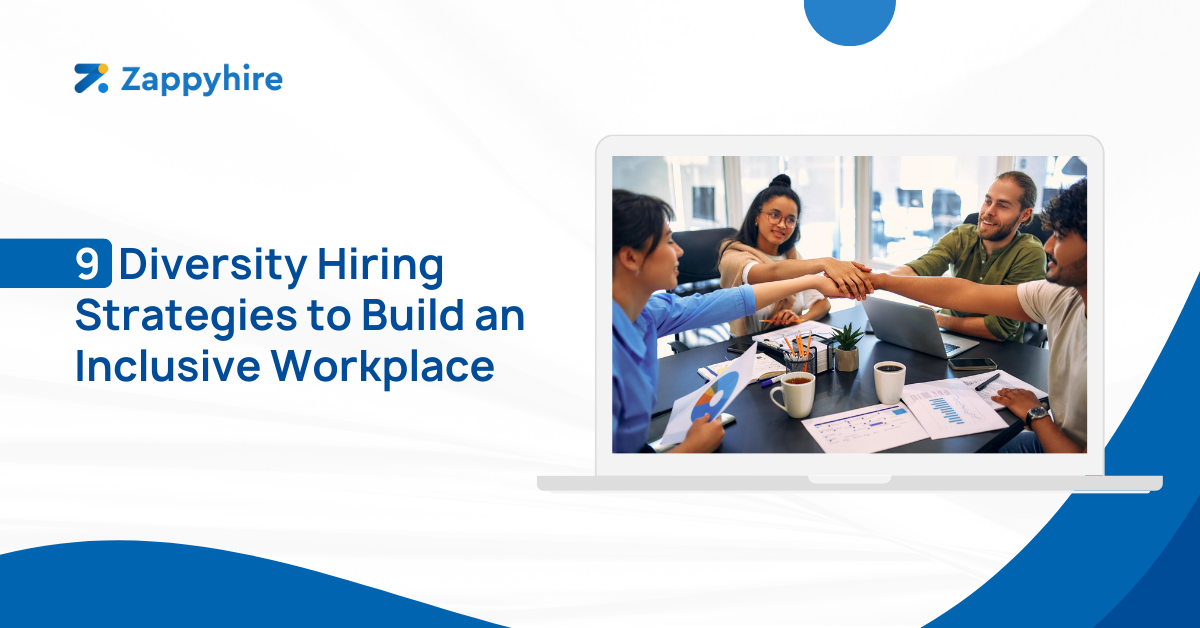
In the quest for talent, there’s an undeniable roadblock, often lurking around in the shadows — unconscious bias. It’s this hidden barrier that stands between organizations and the top-tier talent they seek.
Fortunately, we’ve come a long way from the days when certain groups were given preferential treatment, and today, Diversity, Equity, and Inclusion (DEI) are paramount in the workplace, often even a legal obligation.
Statistics reveal that approximately 32% of workers consider it very important to work in a diverse environment, embracing people of different races, ethnicities, ages, and genders.
In theory, the concept of diversity hiring and the implementation of diversity hiring policies sounds easy enough, but in actuality, it’s not as simple as we consider it to be.
It is therefore crucial to strategize how your organization aims to go about hiring diverse candidates- something this blog aims to explore in depth.
But before we dissect that, let’s start with the whats and whys when it comes to diversity hiring.
- What is diversity hiring?
- Why is diversity hiring important?
- Top challenges in diversity hiring faced by hiring managers
- 9 helpful diversity recruitment strategies for building an inclusive workforce
- Things to embrace and avoid while hiring a diverse workforce
- Key takeaways

What is diversity hiring?
Diversity hiring is all about eliminating biases and prejudices in the recruitment process, ensuring it’s free from any form of discrimination based on personal characteristics that has nothing to do with the job or its requirements.
It’s about prioritizing and creating a workforce that is reflective of the diversity of the world we live in. This means welcoming individuals from various races, religions, socio-economic backgrounds, genders, sexual orientations, and people with disabilities.
It also means welcoming people with different backgrounds and unique perspectives with open arms, for people are unique and have different experiences, and such unique perspectives can drive organizational success.
Why is diversity hiring important?
- Trust and inclusivity in the workplace:
A diverse workforce fosters trust and inclusivity, making employees feel comfortable, valued, and respected at their workplace. Inclusivity and diversity go hand in hand, and they play an integral role in boosting employee morale, productivity and satisfaction.
For instance, research from Deloitte Australia shows that inclusive teams outperform their peers by 80% in team-based assessments – a figure that speaks volumes about the importance of building a diverse and inclusive workforce!
- Enhancing employer brand and reputation:
A diverse and inclusive workforce significantly improves a company’s reputation and plays a critical role in attracting top talent.
According to Glassdoor’s D&I Workplace Survey, close to 66% of job seekers trust employees the most when assessing a company’s diversity and inclusion efforts.
They’re not wrong to do so, as sometimes some organizations resort to projecting false information pertaining to their DEI efforts to avoid media scrutiny, legal actions and as a recruitment marketing tactic.
- Fulfilling social responsibility and legal obligations:
Meeting legal requirements is not only a moral imperative but a legal obligation in certain places as well, and it’s no cakewalk.
It is essential for recruiters to stay abreast with all the laws pertaining to diversity and the amendments associated with them.
Here’s an example as to why it’s crucial to stay updated – Title VII of the Civil Rights Act in the US, protects employees and job applicants from employment discrimination based on race, color, religion, sex, and national origin.
In the above context, it’s essential for employers to understand that, even with the goal of fostering and promoting diversity, they can’t take into consideration a candidate’s race in employment decisions. making legal compliance crucial.
Ironic, isn’t it?

Top challenges in diversity hiring faced by hiring managers
- Unconscious bias and stereotyping:
Unconscious biases are deeply rooted preconceptions and prejudices that often influence our decision-making processes unintentionally.
These biases can subtly taint the hiring process, leading to unfair judgments that lead to a lack of diversity in recruitment.
To address unconscious bias, organizations must implement awareness drives, training sessions to raise awareness among recruiters.
- Sourcing diverse candidates:
Sourcing candidates from diverse backgrounds is a key challenge that recruiters face in diversity hiring.
Recruiters need to actively seek out candidates from various demographics to build a truly inclusive workforce.
To address this challenge, organizations can create and implement diversity hiring policies.
This could help attract a broader pool of candidates by actively promoting inclusivity and diversity in the hiring process.
- Retention and inclusion:
Recruiting a diverse workforce is just the beginning; retaining and including employees is where the challenge lies.
A challenge such as this calls for creating an inclusive and welcoming work environment where diverse talent feels comfortable, valued, and respected.
Organizations can achieve this by implementing mentorship and onboarding programs that provide newcomers with guidance and support.
It was observed that employees who feel a sense of belonging report a 56% higher level of overall job performance! A wholesome way to boost productivity, indeed!
- Increase diversity in leadership roles:
Increasing diversity in leadership positions is essential for ensuring that diversity initiatives trickle down throughout the organization and become a deep-rooted part of the company culture.
To achieve this, a systematic, business-led approach is crucial.
CEOs who implement diversity and inclusiveness strategies report enhanced business performance (85%) and a competitive edge in new industries or geographies (56%).
Therefore, organizations can consider investing in strategies to strengthen leadership accountability and capability for Inclusion and Diversity (I&D).
This can involve implementing equality, accountability, and transparency as the three core indicators of inclusion.

9 helpful diversity recruitment strategies for building an inclusive workforce
1) Creating inclusive job descriptions and eligibility criteria:
Creating job descriptions and eligibility criteria that are inclusive is an essential step in attracting a diverse candidate pool.
This involves using language that appeals to a broad range of applicants, avoiding gender-specific terms, and emphasizing qualifications and skills.
The inclusion of highly specific criteria can deter job seekers from considering the role as they may not think they’re the right fit.
The bottom line is to be sensitive and inclusive while creating these, bearing in mind to discard any specifications that are unrelated to the role in question.
Not sure where and how to start? Check out our eBook, “The Ultimate Job Description Toolkit”, to craft job descriptions that attract top talent with 140+ templates for an array of industries and pro tips.

2)Exploring diversity recruiting tools:
Diversity recruiting tools are invaluable for building a more inclusive workforce.
These tools make the recruitment process more efficient and help reduce unconscious bias by automating most tasks at hand.
A few ways diversity recruiting tools can help are:
- Attracting diverse talent: By leveraging diversity recruiting tools, organizations can effectively attract candidates from various backgrounds, going well beyond geographical limitations.
These tools also enable the targeting of underrepresented talent through potential partnership programs with minority-serving institutions, in addition to job boards focused on diversity, and community organizations.
- Sourcing diverse candidates: These tools allow for the sourcing of candidates from diverse demographics and underrepresented groups.
By utilizing diversity recruiting platforms and networks that cater to underrepresented individuals, recruiters can create a talent pool that better reflects the broader population.
- Hiring diverse candidates: The recruitment process is most effective when it’s inclusive and welcoming to candidates of all backgrounds.
Diversity recruiting tools, such as modern Applicant Tracking Systems (ATS) like Zappyhire, ensure that hiring is equitable and fosters diversity.
For example, Zappyhire streamlines recruitment, reduces unconscious bias by anonymizing applicant information, automating repetitive manual tasks (thereby decreasing scope for human bias to creep in) and actively contributes to a more inclusive and diverse workforce.
Additionally, platforms like LinkedIn offer features for promoting job listings to specific demographics, simplifying the process of attracting diverse talent.
3) Structured interviewing and assessment:
Structured and streamlined interviews can help reduce bias in the hiring process.
These interviews involve asking every candidate the same set of predetermined questions in the same order and evaluating their responses accordingly.
By implementing structured interviews and assessment techniques, recruiters can ensure a very objective approach during evaluation, which is just for all candidates, irrespective of their background.
4) Diversity recruiting programs
Implementing diversity recruiting programs is imperative for creating a more inclusive workforce. These programs encompass various aspects of diversity and inclusion, including training, policies, and onboarding.
Here’s a brief overview of the same:
- Diversity training for interviewers and staff:
To eliminate bias and promote inclusion in the recruitment process, organizations must invest in training programs and resources for interviewers and staff.
These sessions equip employees with essential knowledge and skills to conduct unbiased interviews and foster an inclusive work environment.
Topics covered can include recognizing unconscious bias, best practices for promoting diversity and inclusion in the workplace, and how to identify and address microaggressions professionally.
- Diversity hiring policy:
Establishing a clear and well-defined diversity hiring policy is non-negotiable when it comes to an inclusive workforce.
This policy outlines and forms the foundation of the organization’s commitment to diversity and equity in recruitment.
5) Inclusive onboarding and mentorship programs:
Onboarding and mentorship programs play a significant role in the retention of diverse talent.
These programs welcome newcomers, make them feel comfortable and offer guidance, helping them integrate into the organization quickly and effectively.
For example, assigning a “buddy” or a mentor to new hires can provide them with a much-needed support system to assist in their professional growth.
6) Measuring and tracking diversity metrics:
Measuring and tracking diversity metrics is crucial for monitoring progress.
In fact, diversity and inclusion impact is among the critical recruitment KPIs business leaders must know. Organizations should routinely collect and analyze data to understand where they stand when it comes to implementing DEI strategies.
Key metrics must also include the representation of different demographic groups within the workforce, promotion, and retention rates, and demographic data on incoming candidates.
There are numerous recruitment automation software to assist in the collection and analysis of these data.
7) Adapting to changing demographics and needs:
Diversity is dynamic and is constantly evolving. Therefore, employers must remain responsive to these changes, which can be exemplified by monitoring the shifting demographics within their workforce.
For instance, as younger generations enter the job market, they may bring with them different expectations, opinions, and preferences regarding diversity and inclusion.
A recent survey found that 83% of Gen-Z candidates said that a company’s commitment to diversity and inclusion is important when choosing an employer.
To remain relevant and effective, organizations should adapt their diversity initiatives to encompass these evolving demographics.
8) Using blind resumes and interviewing:
Implementing blind resumes and interviews can be an effective strategy to weed out unconscious bias.
By eliminating personally identifiable information from the pre-screening stages and the assessments and interview stages, recruiters can focus solely on qualifications and skills, ensuring a fairer and more inclusive hiring process.
Here’s an interesting fact for your perusal:
Post a racial discrimination case in 1969, many orchestras began employing blind auditions.
Subsequent studies found that blind auditions actually increased the chances of women being hired by 25–46%!
9) Build an employer brand that promotes diversity:
Developing a strong employer brand that proactively promotes diversity and inclusion is a strategic move that every employer must adapt to.
This kind of branding not only attracts diverse talent but also conveys the organization’s commitment to fostering an inclusive work environment.
Some ways to create an employer brand is to actively promote diversity and inclusion by incorporating inclusive images on your main website, career page, and media pages to showcase the diversity of your team and reflect your desired state.
Job seekers need to see how your company promotes diversity and inclusion.
It is also crucial for leaders to actively engage and communicate their plans to incorporate diversity hiring strategies into their hiring processes to ensure that the workplace remains inclusive.
Demonstrating this commitment to your employer brand can significantly impact your ability to attract top talent from various backgrounds.

Things to embrace and avoid while hiring a diverse workforce
- Embrace: Foster an inclusive company culture:
Establish a work environment where every employee feels seen, heard, valued, respected, and empowered to be their authentic selves.
Organizations can celebrate diverse cultural events, provide flexible work arrangements, and establish groups that encourage rapport-building among employees from similar backgrounds.
- Embrace: Collaborate with diverse organizations:
Partnering with diverse organizations like minority-focused organizations, universities with diverse student populations, and community groups can provide access to a broader range of candidates.
- Embrace: Continuous learning and adaptation:
Employers should stay in the know about the latest best practices, legal policies, changes in demographics, and emerging diversity challenges.
This can involve attending diversity conferences, participating in industry forums, and being open to evolving strategies.
- Embrace: Leveraging recruitment automation tools:
Leveraging advanced tools like Applicant Tracking Systems (ATSs) can significantly aid in effective diversity hiring.
For example, advanced ATSs like Zappyhire can help organizations anonymize applicant information, track diversity metrics, and streamline the recruitment process while reducing the influence of unconscious bias.
- Avoid: Relying solely on quotas:
Relying solely on quotas for diversity can be quite limiting and counterproductive.
Organizations must focus on the value that individuals bring to the organization rather than focusing on setting quotas based on demographic characteristics.
- Avoid: Tokenism:
Tokenism occurs when a company superficially includes individuals from underrepresented groups to appear inclusive without genuinely attributing value to their contributions.
Instead, employers should focus on creating a culture where all employees are genuinely appreciated for their skills, experiences, and unique perspectives.
- Avoid: Ignoring intersectionality:
Employers should acknowledge that individuals have multiple dimensions of diversity, such as race, gender, age, and sexual orientation, and should consider these layers in their hiring efforts.
Ignoring intersectionality can result in overlooking the unique challenges faced by individuals with more than one marginalized identity.
Key takeaways:
- Diversity hiring encompasses awareness, training, and pursuing candidates from various backgrounds to create an inclusive workforce.
- Organizations must educate, train, and implement strategies like blind recruitment processes, to combat unconscious biases.
- One must proactively source diverse candidates by implementing diversity hiring policies to attract a wider, diverse, and more inclusive talent pool.
- Elevating diversity to leadership roles is crucial for fostering a culture of inclusivity in the organization.
- Measuring and tracking diversity metrics is essential for assessing progress and understanding the changing demographics within the workforce.
- Adopt diversity recruiting tools, fostering an inclusive culture, collaborating with diverse organizations, and promoting continuous learning.
- Avoid the reliance on quotas, tokenism, and ignoring intersectionality to ensure that diversity efforts remain genuine and impactful.
- Word of caution: Despite the best intentions, even with advancements in AI and machine learning, bias can persist.
For example, Amazon’s AI recruitment program faced criticism for being biased against women, highlighting the need for ongoing vigilance in diversity hiring practices.
In conclusion, diversity hiring is not just a trend; it’s a strategic imperative that can lead to organizational success.
Today it goes well beyond a moral and ethical requirement and becomes a strategic necessity.
Employers must actively adopt and implement these strategies to build an inclusive workforce that genuinely reflects the rich diversity of the world we live in, thereby harnessing the power of diverse perspectives, experiences, and backgrounds to drive organizational success.






